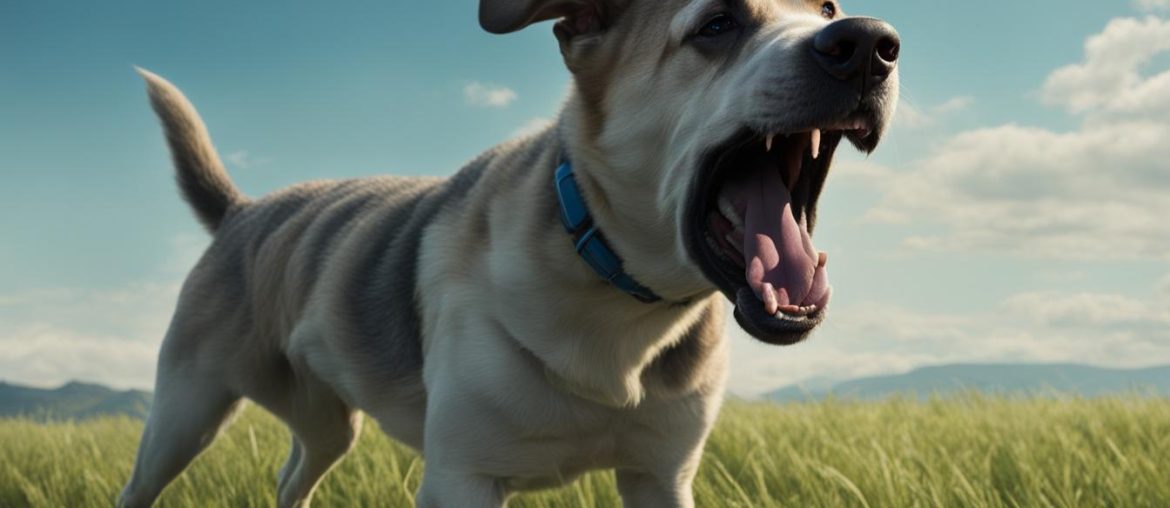Reverse sneezing, also known as paroxysmal respiration, is a condition in dogs that causes them to rapidly pull air in through the nose, resulting in a loud snorting sound. It is a common occurrence in small dogs and is typically harmless. The exact cause of reverse sneezing is unknown, but it is believed to be triggered by irritation or inflammation of the nasal, pharyngeal, or sinus passages. Dogs may experience reverse sneezing episodes when exposed to irritants such as dust, nasal mites, pollen, or smoke. While it can be alarming, most dogs return to normal after a short episode.
Key Takeaways:
- Reverse sneezing is a common respiratory reflex in dogs.
- It is characterized by rapid inhalations through the nose, resulting in snorting sounds.
- Reverse sneezing is usually harmless and does not require medical intervention.
- Irritants like dust, nasal mites, pollen, or smoke can trigger reverse sneezing episodes.
- If a dog experiences other concerning symptoms or if episodes are severe or chronic, consult a veterinarian for proper diagnosis and treatment.
What Causes Reverse Sneezing in Dogs?

Reverse sneezing in dogs can be caused by various factors. Some common triggers include inflammation or irritation of the nasal, pharyngeal, or sinus passages. This can be due to nasal mites, dust, pollen, smoke, or other irritants. Dogs may also experience reverse sneezing when they are over-excited.
It is important to note that reverse sneezing is usually a harmless reflex and does not pose any long-term health risks for most dogs.
| Causes of Reverse Sneezing in Dogs | Symptoms |
|---|---|
| Inflammation or irritation of the nasal passages | Rapid inhalation through the nose |
| Nasal mites | Loud snorting or gagging sounds |
| Dust, pollen, or other irritants | Brief episodes lasting less than a minute |
| Over-excitement | No other associated symptoms |
While reverse sneezing in dogs is usually not harmful, it is important to monitor your dog’s behavior and consult a veterinarian if you have any concerns. They can help determine if there are any underlying health issues contributing to the reverse sneezing and provide appropriate treatment or management strategies.
Is Reverse Sneezing Harmful for Dogs?
For the majority of dogs, reverse sneezing is not harmful and does not require medical intervention. The episodes typically last for less than a minute, and dogs resume their normal activities afterward. However, in some cases, reverse sneezing may be a sign of an underlying health problem. Dogs experiencing other symptoms such as labored breathing, consistent cough, wheezing, or pale gums should be examined by a veterinarian to rule out conditions like asthma, heart disease, or tracheal collapse.
In most cases, reverse sneezing in dogs is a benign reflex and does not have any long-term health repercussions. It is important for pet owners to understand that reverse sneezing is a normal physiological response and is not a cause for immediate concern. However, if a dog is showing additional symptoms or if the reverse sneezing episodes are becoming more frequent or severe, it is recommended to seek veterinary care for a thorough examination and proper diagnosis.
Common Symptoms of Underlying Health Problems in Dogs:
- Labored breathing
- Consistent coughing
- Wheezing
- Pale gums
These symptoms may indicate more serious health issues, and it is crucial to consult with a veterinarian to determine the underlying cause and appropriate treatment. By addressing any potential underlying health problems, pet owners can ensure the overall well-being and comfort of their dogs.
Table: Symptoms of Reverse Sneezing vs. Underlying Health Problems
| Reverse Sneezing | Underlying Health Problems |
|---|---|
| Short episodes lasting less than a minute | Episodes may be longer and more frequent |
| Normal breathing between episodes | Labored breathing even when not reverse sneezing |
| No other symptoms present | Consistent coughing, wheezing, or pale gums |
Understanding the difference between normal reverse sneezing and symptoms of underlying health problems is essential for pet owners to provide the appropriate care and attention to their dogs. While reverse sneezing is usually harmless, it is always better to err on the side of caution and consult with a veterinarian if there are any concerns.
Symptoms of Reverse Sneezing in Dogs
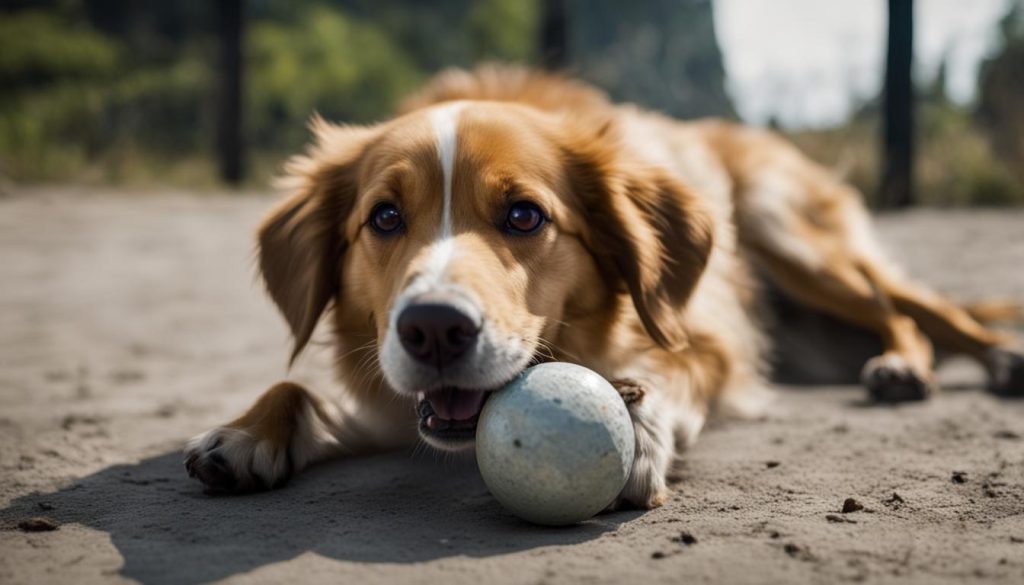
While reverse sneezing itself is usually not accompanied by any other symptoms, it can sometimes be a sign of underlying health issues in dogs. It’s important to be aware of any additional signs that may indicate a more serious problem. Some common symptoms to watch out for include:
- Labored breathing: If your dog is having difficulty breathing during or after a reverse sneezing episode, it could be a sign of an underlying respiratory condition.
- Consistent coughing: Persistent coughing along with reverse sneezing may indicate an infection or inflammation in the airways.
- Wheezing: A wheezing sound during reverse sneezing could be a symptom of asthma or other respiratory disorders.
- Pale gums: If your dog’s gums appear pale or blue, it may suggest a lack of oxygen and should be evaluated by a veterinarian.
Please be aware that these symptoms are not exclusive to reverse sneezing and may indicate other health problems. If your dog is experiencing any of these symptoms alongside reverse sneezing episodes, it is recommended to consult with a veterinarian for a proper diagnosis and appropriate treatment.
Irritation or inflammation of the nasal, pharyngeal, or sinus passages can cause reverse sneezing in dogs. This can be triggered by exposure to irritants such as dust, pollen, or smoke.
By closely monitoring your dog’s symptoms and seeking veterinary care when necessary, you can ensure the overall health and well-being of your furry friend.
| Symptom | Possible Causes |
|---|---|
| Labored breathing | Underlying respiratory condition, such as asthma or bronchitis |
| Consistent coughing | Infection or inflammation in the airways |
| Wheezing | Asthma or other respiratory disorders |
| Pale gums | Lack of oxygen |
Recognizing the Signs of Underlying Health Problems
While reverse sneezing itself is typically harmless, it’s important to recognize any signs of underlying health problems in your dog. Some of these signs include:
- Difficulty breathing or shortness of breath
- Persistent coughing or wheezing
- Lethargy or lack of energy
- Loss of appetite or weight loss
- Changes in behavior or temperament
If you notice any of these signs in conjunction with reverse sneezing, it’s recommended to consult with a veterinarian for further evaluation and appropriate treatment. Early detection and treatment of underlying health issues can help ensure the best possible outcome for your dog.
How to Help a Dog Through a Reverse Sneezing Episode

When your dog experiences a reverse sneezing episode, it can be alarming to witness. However, there are some simple steps you can take to help ease their discomfort and shorten the duration of the episode. Here are some techniques that can be effective in managing reverse sneezing in dogs:
- Stay calm and upbeat: Dogs are highly attuned to their owner’s emotions, so remaining calm and reassuring can help reduce your dog’s anxiety during the episode.
- Massage their throat gently: By gently massaging your dog’s throat, you can encourage swallowing and help stop the reverse sneezing episode.
- Lift their head up and down: Gently lifting your dog’s head up and down can help open their airway and alleviate the reverse sneezing episode.
- Distract them: Offering your dog a toy, treat, or meal during a reverse sneezing episode can help divert their attention and reduce the duration of the episode.
Please be aware that in most cases, medical treatment is not necessary for reverse sneezing in dogs. These episodes generally resolve on their own within a minute or two. However, if you notice that your dog’s reverse sneezing episodes are severe, chronic, or allergy-related, it may be beneficial to consult with a veterinarian for further evaluation and potential treatment options.
| Technique | Description |
|---|---|
| Stay calm and upbeat | Remaining calm and reassuring can help reduce your dog’s anxiety during a reverse sneezing episode. |
| Massage their throat gently | Gently massaging your dog’s throat can encourage swallowing and help stop the reverse sneezing episode. |
| Lift their head up and down | Gently lifting your dog’s head up and down can help open their airway and alleviate the reverse sneezing episode. |
| Distract them | Offering your dog a toy, treat, or meal during a reverse sneezing episode can help divert their attention and reduce the duration of the episode. |
By implementing these techniques and providing your dog with a calm and stress-free environment, you can help manage reverse sneezing episodes and ensure the well-being of your canine companion.
When to Seek Veterinary Care for Reverse Sneezing
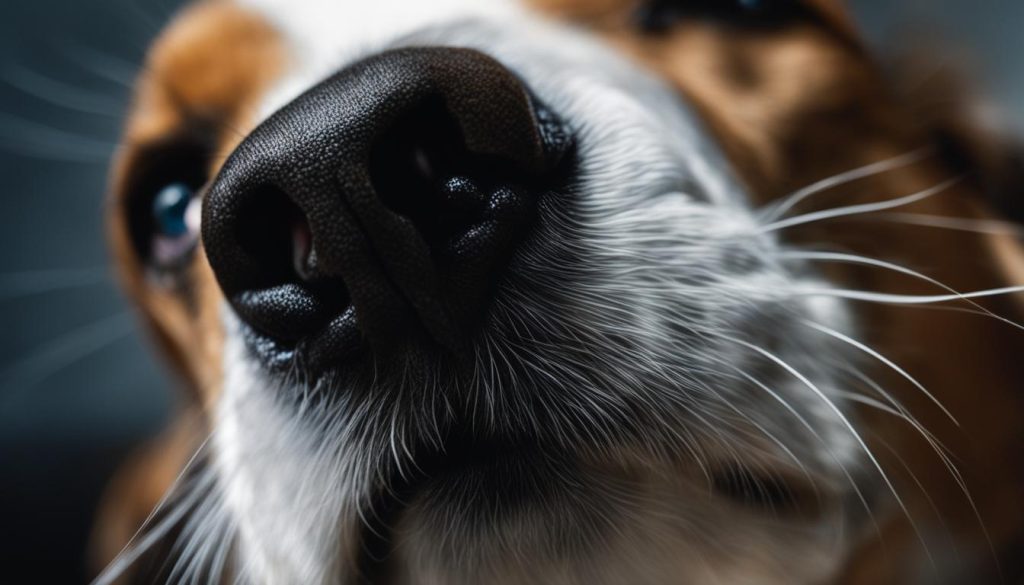
If your dog experiences reverse sneezing, it is usually not a cause for concern. Most dogs will return to normal after a short episode, and it does not pose any long-term health risks. However, there are instances where it is advisable to seek veterinary care.
If your dog suddenly develops reverse sneezing or exhibits other symptoms such as labored breathing, consistent coughing, or lethargy, it is important to have them examined by a veterinarian. These could be signs of an underlying health problem such as asthma, heart disease, or tracheal collapse. It is always better to err on the side of caution and have a professional evaluate your dog’s condition.
A veterinarian will be able to assess your dog’s overall health and determine if further diagnostic tests or treatments are necessary. They can rule out any underlying conditions and provide appropriate care and guidance for your furry friend. Seeking veterinary care can help ensure the well-being of your dog and provide peace of mind for you as an owner.
Table: When to Seek Veterinary Care for Reverse Sneezing
| Symptoms | Action |
|---|---|
| Reverse sneezing with sudden onset | Consult a veterinarian |
| Labored breathing | Consult a veterinarian |
| Consistent coughing | Consult a veterinarian |
| Lethargy | Consult a veterinarian |
By seeking veterinary care when necessary, you can ensure your dog receives the appropriate attention and care for their health. Remember, it is always better to consult with a professional to rule out any potential underlying health issues and provide the best possible care for your furry companion.
Canine Infectious Respiratory Disease Complex (CIRDC)
Canine Infectious Respiratory Disease Complex (CIRDC), also known as Kennel Cough Complex, is a respiratory disease that affects dogs of all sizes and breeds. It has been observed more frequently in dogs recently, and it is important for pet owners to be aware of this condition and its symptoms. In some cases, CIRDC can be mistaken for reverse sneezing, as it can cause similar respiratory symptoms.
CIRDC is typically characterized by coughing, sneezing, nasal discharge, and other respiratory symptoms. It is caused by a combination of viruses and bacteria, including Bordetella bronchiseptica, canine parainfluenza virus, and canine adenovirus. Dogs may contract CIRDC through direct contact with infected dogs or through exposure to contaminated surfaces, such as kennels or grooming facilities.
If you suspect that your dog may have CIRDC, it is recommended to consult with a veterinarian for proper diagnosis and treatment. Your veterinarian may perform tests to rule out other respiratory conditions and may prescribe medications to help relieve symptoms and prevent secondary infections. Additionally, it is important to keep your dog isolated from other dogs to prevent the spread of CIRDC.
Symptoms of Canine Infectious Respiratory Disease Complex (CIRDC)
| Common Symptoms | Less Common Symptoms |
|---|---|
|
|
It is important to note that while CIRDC can cause discomfort and respiratory symptoms in dogs, it is usually a self-limiting condition and most dogs recover with proper care and treatment.
What Happens During a Reverse Sneeze?
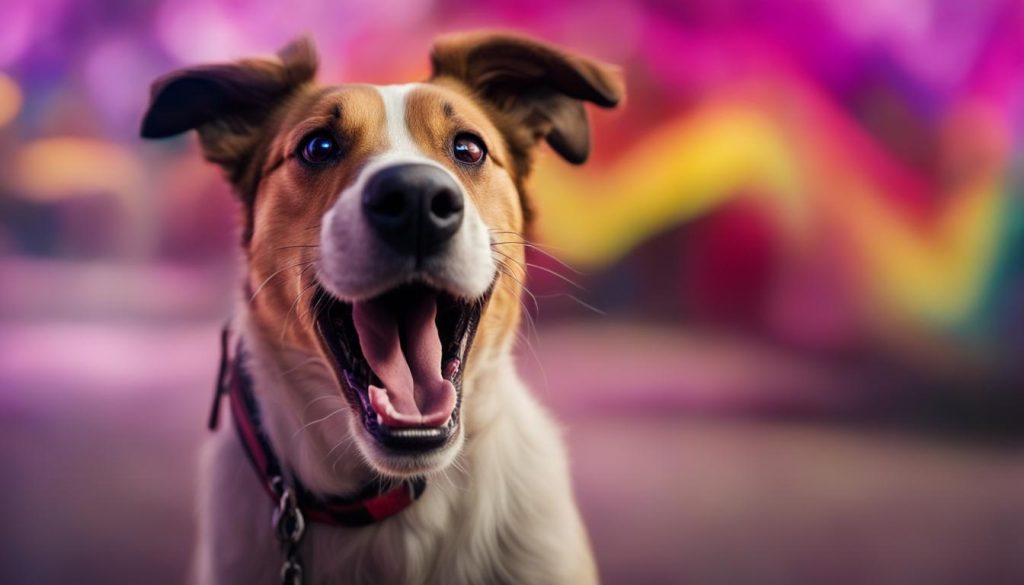
During a reverse sneezing episode, a dog will typically stand still, extend their head and neck, and make rapid and repeated inhalations through the nose. This results in snorting or gagging sounds that can be alarming to an owner. It is important to note that reverse sneezing is not the same as a tracheal collapse, which is a more serious condition characterized by a loud “honking” sound. Reverse sneezing is usually a short-lived event and does not cause any harm to the dog.
While the exact cause of reverse sneezing is unknown, it is believed to be triggered by irritation or inflammation of the nasal, pharyngeal, or sinus passages. Dogs may experience reverse sneezing episodes when exposed to irritants such as dust, nasal mites, pollen, or smoke. Although it can be alarming to witness, most dogs return to normal after a short episode of reverse sneezing.
It is important to differentiate reverse sneezing from other respiratory conditions. If a dog exhibits other concerning symptoms such as labored breathing, consistent cough, wheezing, or pale gums, it is advisable to consult a veterinarian to rule out underlying health problems like asthma, heart disease, or tracheal collapse. By understanding the nature of reverse sneezing and recognizing its distinct characteristics, pet owners can provide appropriate care and reassurance to their furry companions.
Diagnosing Reverse Sneezing in Dogs
When a dog experiences reverse sneezing episodes, it can be concerning for pet owners. To diagnose reverse sneezing in dogs, veterinarians typically rely on a combination of a dog’s medical history and clinical signs. By gathering information about the dog’s health background and carefully observing the symptoms, veterinarians can determine if the episodes are indeed reverse sneezing and not indicative of any underlying conditions or respiratory issues.
During a veterinary examination, the pet owner may be asked questions about the dog’s previous episodes of reverse sneezing, including the frequency, duration, and any potential triggers. The veterinarian will also perform a physical examination to check for any abnormalities in the respiratory system. In some cases, additional diagnostic tests such as blood work or radiographs may be recommended to rule out other possible causes of abnormal breathing or snorting.
Clinical signs that are commonly associated with reverse sneezing include the rapid and repeated inhalations through the nose, snorting or gagging sounds, and the characteristic stance of a dog during an episode. By carefully evaluating these signs and ruling out other potential causes, veterinarians can reach a diagnosis of reverse sneezing in dogs.
| Diagnosing Reverse Sneezing in Dogs |
|---|
| Medical History |
| Ask pet owner about previous episodes, frequency, duration, and triggers |
| Clinical Examination |
| Physical examination to check for any respiratory abnormalities |
| Additional Tests |
| Blood work, radiographs, or other diagnostic tests to rule out underlying conditions |
During a veterinary examination, the pet owner may be asked questions about the dog’s previous episodes of reverse sneezing, including the frequency, duration, and any potential triggers. The veterinarian will also perform a physical examination to check for any abnormalities in the respiratory system. In some cases, additional diagnostic tests such as blood work or radiographs may be recommended to rule out other possible causes of abnormal breathing or snorting.
Treatment for Reverse Sneezing in Dogs
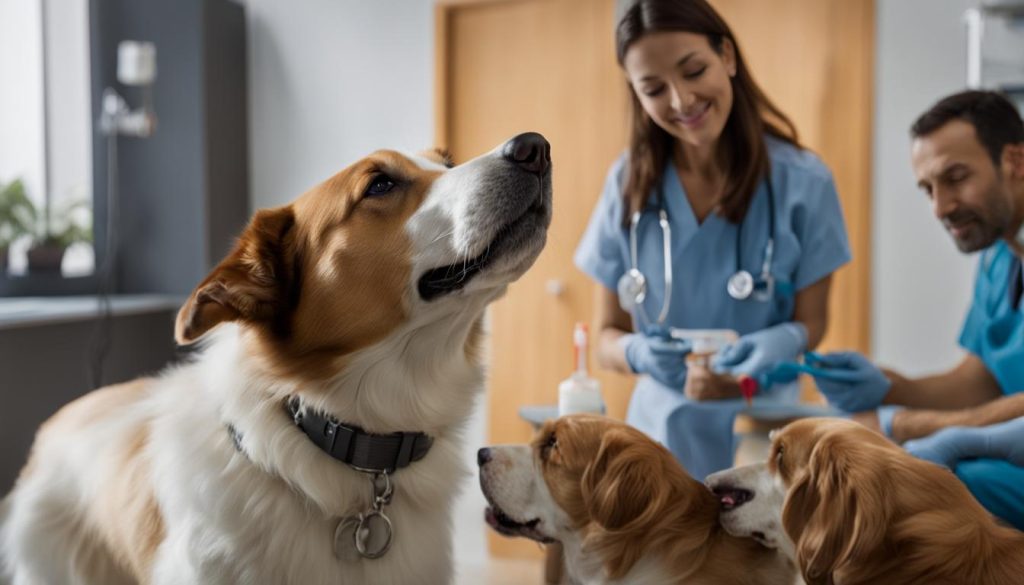
Reverse sneezing in dogs is a common respiratory reflex that is usually harmless and does not require medical treatment. Most dogs will return to normal after a short episode of reverse sneezing, and there are typically no long-term health risks associated with this condition. However, if your dog experiences severe or chronic reverse sneezing episodes, or if they are allergy-related, veterinary intervention may be recommended.
While there is no specific medical treatment for reverse sneezing, there are steps you can take to help your dog through an episode and manage their condition. You can gently stroke their neck to calm them down and encourage swallowing. You can also cover their nostrils for a few seconds or lightly blow in their face to clear out any irritants. These techniques can offer immediate relief and help stop the reverse sneezing episode.
In addition to providing immediate relief, managing your dog’s environment can also help prevent future episodes of reverse sneezing. Creating a calm and stress-free environment for your dog can reduce anxiety and over-excitement, which are common triggers for reverse sneezing. Additionally, evaluating the environment for potential irritants such as perfumes or carpet cleaners can help minimize triggers and reduce the frequency of reverse sneezing episodes.
In most cases, with proper management and care, reverse sneezing in dogs can be effectively handled at home without the need for medical treatment. However, if you have any concerns or if your dog’s symptoms worsen or persist, it is always best to consult with a veterinarian for a proper diagnosis and guidance on the best course of action for your furry friend.
Tips for Managing Reverse Sneezing in Dogs
If your dog experiences reverse sneezing episodes, there are steps you can take to help manage and reduce their frequency. By creating a calm and stress-free environment for your dog, you can minimize triggers that may induce episodes. Additionally, evaluating your dog’s surroundings for potential irritants like perfumes or carpet cleaners can be beneficial in preventing reverse sneezing.
During a reverse sneezing episode, staying calm and providing reassurance to your dog can help reduce their anxiety and stress. Gentle massaging of their throat may encourage swallowing and help stop the episode. Lifting their head up and down or distracting them with a toy, treat, or meal can also be effective in easing their discomfort. It is important to note that in most cases, medical treatment is not necessary for reverse sneezing in dogs.
Observing your dog’s behavior and noting any patterns or triggers can provide valuable insights that can help you manage reverse sneezing episodes. It is also important to remember that reverse sneezing is generally a harmless reflex and does not pose any long-term health risks for most dogs. However, if your dog experiences other concerning symptoms or if the reverse sneezing episodes are severe or chronic, it is advisable to consult with a veterinarian for proper diagnosis and treatment.
| Tip | Description |
|---|---|
| 1 | Create a calm environment |
| 2 | Evaluate for potential irritants |
| 3 | Stay calm and provide reassurance |
| 4 | Gently massage the throat |
| 5 | Lift the head up and down or distract with a toy, treat, or meal |
Wrapping Up
Reverse sneezing is a common, usually harmless respiratory reflex in dogs. While it can be alarming for pet owners, it typically does not require medical intervention. Most dogs return to normal after a short episode of reverse sneezing, and there are generally no long-term health risks associated with this condition.
However, if a dog experiences other concerning symptoms or if reverse sneezing episodes are severe or chronic, it is advisable to consult with a veterinarian for proper diagnosis and treatment. It’s important to understand that reverse sneezing can sometimes be a sign of an underlying health problem, such as asthma, tracheal collapse, or heart disease.
By understanding and managing reverse sneezing, pet owners can ensure the well-being of their canine companions. Staying calm during episodes, providing gentle throat massages, and minimizing environmental triggers can help alleviate discomfort. Remember, a veterinarian should be consulted if there are any concerns about a dog’s overall health or if the reverse sneezing becomes frequent or severe.
Overall, with proper awareness and care, pet owners can help their dogs navigate through reverse sneezing episodes and maintain their overall health and happiness.
FAQ
What is reverse sneeze in a dog?
Reverse sneezing, also known as paroxysmal respiration, is a condition in dogs that causes them to rapidly pull air in through the nose, resulting in a loud snorting sound.
What causes reverse sneezing in dogs?
Reverse sneezing in dogs can be caused by various factors, including inflammation or irritation of the nasal, pharyngeal, or sinus passages. It can also be triggered by nasal mites, dust, pollen, smoke, or over-excitement.
Is reverse sneezing harmful for dogs?
For the majority of dogs, reverse sneezing is not harmful and does not require medical intervention. However, it can be a sign of an underlying health problem in some cases.
What are the symptoms of reverse sneezing in dogs?
During a reverse sneezing episode, a dog may exhibit rapid and repeated inhalations through the nose, resulting in snorting or gagging sounds. However, reverse sneezing itself is usually not accompanied by other symptoms.
How can I help a dog through a reverse sneezing episode?
Staying calm, massaging the throat gently, or distracting the dog with a toy or treat can help ease their discomfort during a reverse sneezing episode.
When should I seek veterinary care for reverse sneezing?
If your dog suddenly develops reverse sneezing or exhibits other concerning symptoms like labored breathing, consistent coughing, or lethargy, it is important to have them examined by a veterinarian.
What is Canine Infectious Respiratory Disease Complex (CIRDC)?
CIRDC, also known as Kennel Cough Complex, is a respiratory disease that can affect dogs of all sizes and breeds. It can cause coughing, sneezing, nasal discharge, and other respiratory symptoms.
What happens during a reverse sneeze?
During a reverse sneezing episode, a dog will typically stand still, extend their head and neck, and make rapid and repeated inhalations through the nose, resulting in snorting or gagging sounds.
How is reverse sneezing in dogs diagnosed?
The diagnosis of reverse sneezing is typically based on a dog’s medical history and clinical signs. In some cases, additional tests such as blood tests or radiographs may be performed to rule out underlying conditions.
Is treatment necessary for reverse sneezing in dogs?
In most cases, reverse sneezing in dogs does not require medical treatment. Pet owners can help their dogs through a reverse sneezing episode by providing immediate relief and creating a calm environment.
How can I manage reverse sneezing in dogs?
Pet owners can manage reverse sneezing in dogs by providing a stress-free environment, minimizing potential irritants, and evaluating the dog’s environment. By identifying and minimizing triggers, the frequency of reverse sneezing episodes can be reduced.


